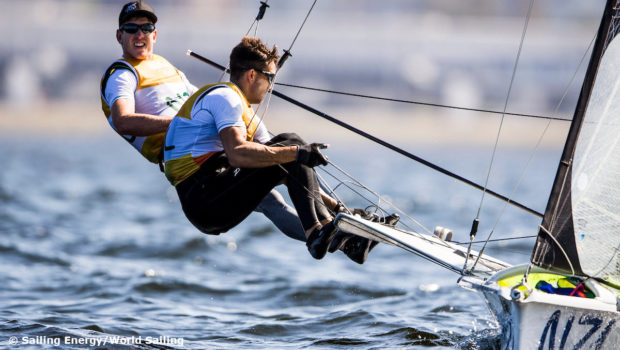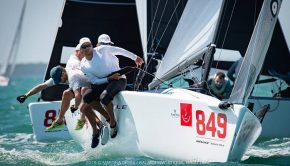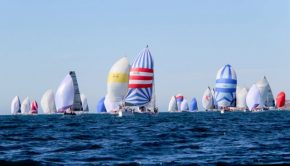Navigating the Code – Olympic and Elite Squad Sailors
Published on September 27th, 2016
The Sailor Classification Code exists as a service to provide Events and Classes with an international system of classification for sailors. Under the Code, sailors are classified as either Group 1 (amateur) or Group 3 (professional).
For Events and Classes seeking to either limit the influence of Group 3 sailors, or striving to recognize teams with all Group 1 sailors, the Sailor Classification Code is the system that is used. However, due to the wide range of jobs within the marine industry, the skills of Group 3 sailors is equally broad.
While US Rolex Yachtsman of the Year winners Ed Baird and Paul Cayard are clearly impactful professionals, and get paid well for their crewing services, sailors who seek to represent their country at the Olympics can also find themselves within the scope of the classification:
For sailors who have reached their 24th birthday:
Q. A sailor is a member of an Olympic squad, development squad or similar squad or team and receives grant funding because of this. Is he/she Group 3?
A. (a) Yes. Membership of a squad or team is work for which the sailor is paid. The sailor’s work in this case will include competing and/or managing, training, practicing, tuning, testing, maintaining or otherwise preparing himself and his boat for racing.
(b) The only exception to this is if the grant funding is no more than the sailor’s personal expenses (which may be no more than the amount of reasonable expense incurred for entry fees, travel, accommodation and meals in connection with and necessary for specific events).
Q. Does a sailor become Group 3 just because he/she competes in an Olympics?
A. No. However, it is likely that an Olympic athlete receives support from his or her MNA (national authority) and this will need to be considered if it constitutes pay.
Q. A sailor is a member of an Olympic squad, development squad or similar squad or team and does not receive grant funding. However, he/she receives free or subsidized coaching, shipping, access to professional advice or services (such as fitness training, medical services, physiotherapy, weather forecasting etc.). Is the sailor a Group 3?
A. Yes. See first answer above. Pay includes money’s worth and benefits in kind. The receipt of free or subsidized equipment or services is a benefit in kind.
Q. A Group 3 sailor competes in an Olympic Sailing Competition. Does this affect his classification status?
A. Yes. From 1 December 2011 onwards, any Group 3 sailor who competes in an Olympic Sailing Competition will remain Group 3 for 5 years after the final day of racing at the Olympics or until the expiry of the usual Group 3 timeout period of 2 years (whichever is the later). This applies whether or not the sailor was Group 1 or 3 at the time of the Olympics.
For example, a sailor is Group 1 and competes at the London 2012 Olympics. In August 2013, he/she becomes a Group 3 sailor. Because he.she competed in an Olympic Sailing Competition, he/she is now Group 3 until August 2017 as this is 5 years from the end of the Olympics in which he/she competed, whether or he/she has ceased any Group 3 activities since that time.
In August 2017, the sailor can apply for a new classification and the usual Qualification Period of the 2 years prior to the application date will be considered.
Sailors are referred to ISAF Regulation 22.2.3.
Q. Does this apply to sailors who competed in the 2008 Olympics or earlier?
A. No. It only applies for the 2012 Olympics in London and later Olympiads.
Q. Does this apply to the Paralympic Sailing Competition?
A. No.
Q. A sailor is employed in an organization that provides him with additional paid leave and/or contributes to his expenses to race, practice or prepare. Is he/she a Group 1 sailor?
A. No, he/she is Group 3.
Q. A sailor receives from a commercial organization a contribution to his living expenses and/or the running expenses of his campaign over and above those allowed as ‘personal expenses’ (see page 5). Is he/she a Group 1 sailor?
A. Not normally. The sailor is Group 3 if the contribution is accepted in return for selling, promoting or advertising the donor’s products, services or support or allowing his name, reputation or likeness to be used in any way for any commercial purpose [22.2.2(f)]. Otherwise the sailor is Group 1.
Q. A sailor receives from his family or friends a contribution to his living expenses and/or the running expenses of his campaign over and above those allowed as ‘personal expenses’ (see page 5). Is he/she a Group 1 sailor?
A. Yes, provided the contribution has not been structured to avoid the sailor otherwise being Group 3.
Q. A sailor receives from another sailor a donation towards the costs of his living expenses and/or the running expenses of his campaign over and above those allowed as ‘personal expenses’ (see page 5). In return he/she is required to race with the donor. Is he/she a Group 1 sailor?
A. No, he/she is Group 3.
Q. A sailor receives from a ‘not for profit’ sports organization, National Authority, other Government body, foundation or charity a contribution to his living expenses and/or the running expenses of his campaign over and above those allowed as personal expenses’ (see page 5). Is he/she a Group 1 sailor?
A. (a) No. He/she is Group 3 if the organization includes in its objectives support for the achievement of success by a team or individual in high level competition and/or promotes their success publicly. Examples include the National Authority, Government bodies and Sports Foundations; or
(b) Yes. He/she is Group 1 if the members of an organization, such as a Sailing Club, hold a fund raising event for the members to make personal contributions; or
(c) No. He/she is Group 3 if the contribution comes as part or all of a grant, bursary or scholarship.
Q. If a sailor is provided with free or subsidized coaching, fitness coaching etc is he/she Group 3?
A. Yes as these are goods or services that have a monetary value (see definition of pay).
Q. A sailor is lent a boat for a campaign or event and returns it afterwards. Does this affect his classification?
A. No, however if the boat was given to the sailor and he sold it and retained the proceeds he would become Group 3.
For sailors who are over 18 but have not yet reached their 24th birthday, Group 3 activity is determined as above and the time limit on exemption (100 days in 24 months) is calculated as follows:
Where the contribution or grant does not include a contribution to ‘living costs’ of a campaign the number of days of Group 3 activity will comprise those spent on everything set out in Regulation 22.2.2 plus any days spent on Group 3 activity for any other race preparation or racing.
Where the contribution or grant includes lump sums and allowances which are not for specific events the total period for which they are paid, i.e. 3 months, I year etc. will be used to establish the number of days involved.
Q. A sailor receives an annual grant towards his campaign expenses. Is he/she Group 3?
A. Yes. This would make him Group 3. His grant is for more than 100 days even though he/she may race for less than 100 days.
Q. In addition to personal expenses for specific events a sailor receives coaching, general advice and sometimes boat transport costs from his MNA as part of his membership of a squad or team. Is he/she Group 3?
A. Yes, if membership is for a period longer than 100 days.









 We’ll keep your information safe.
We’ll keep your information safe.